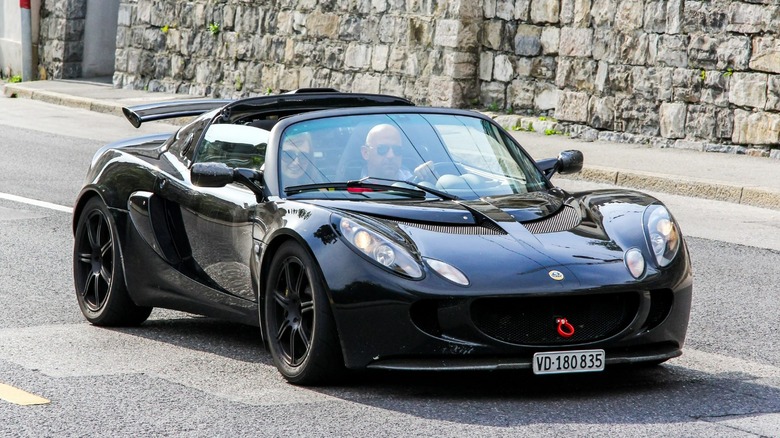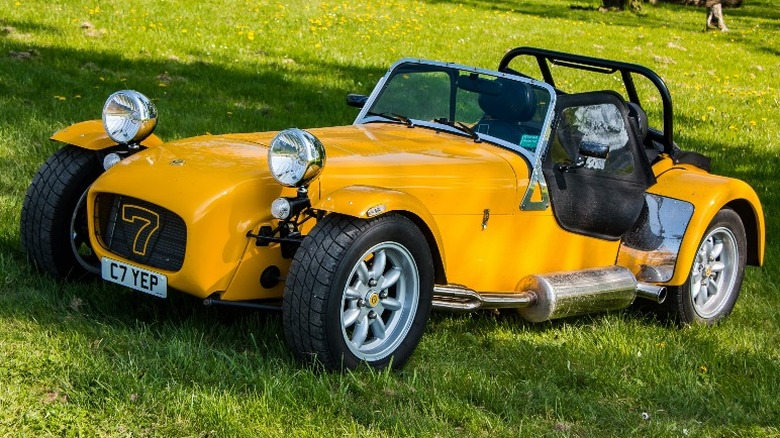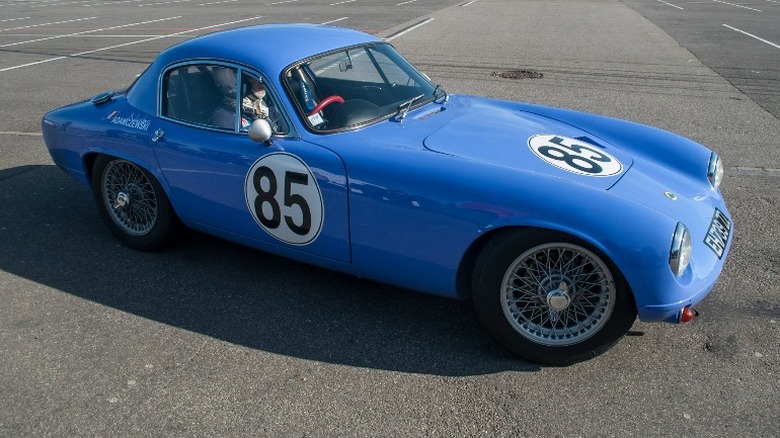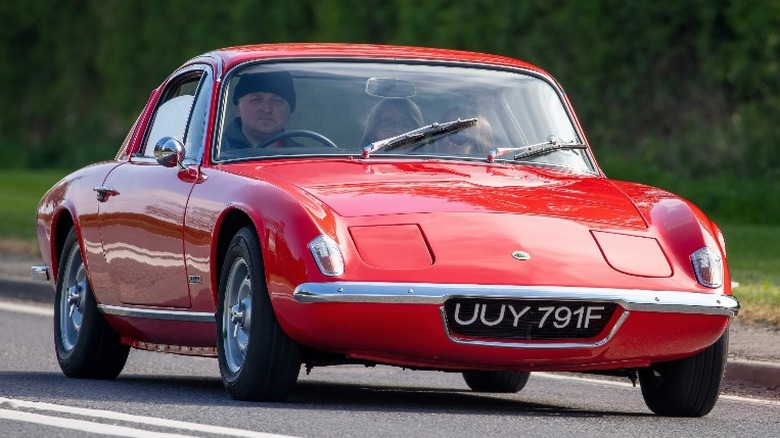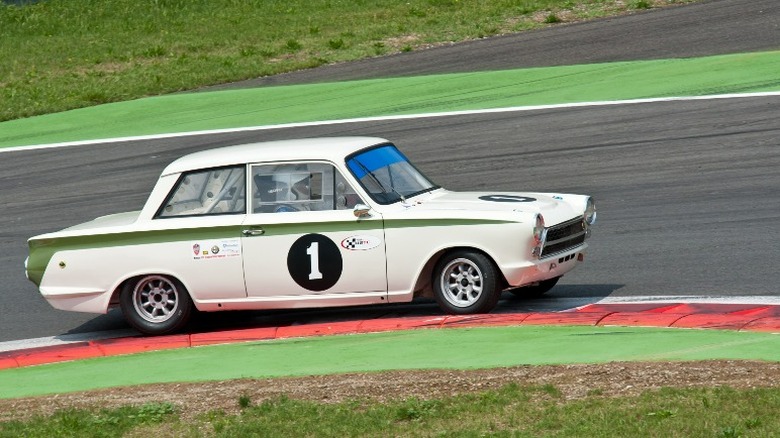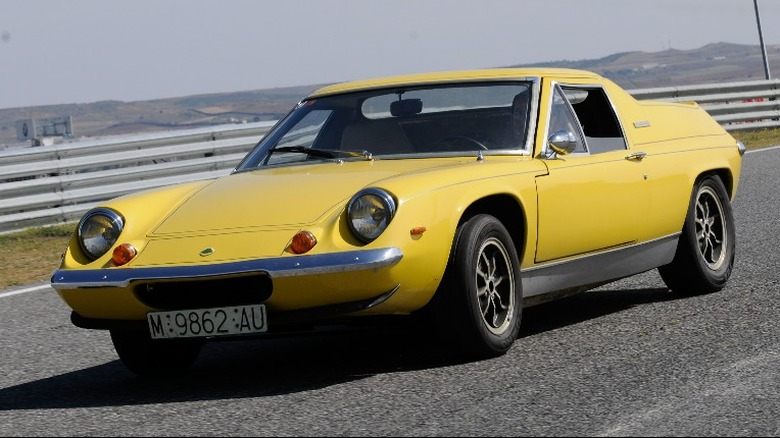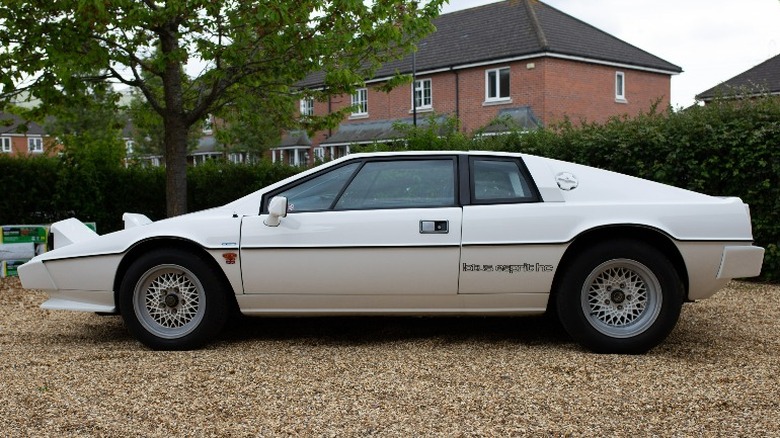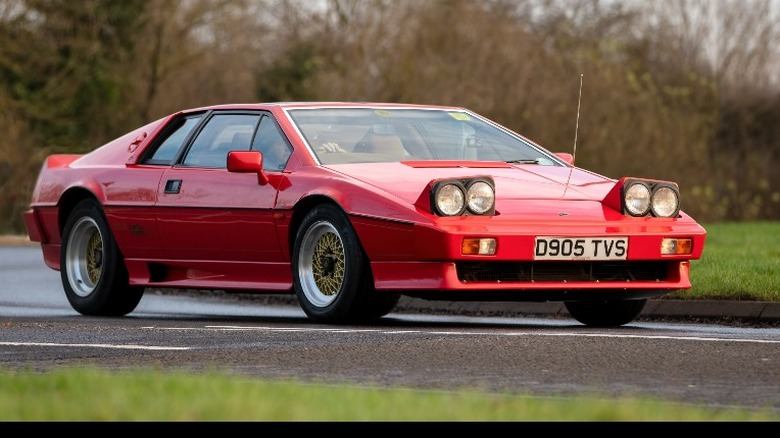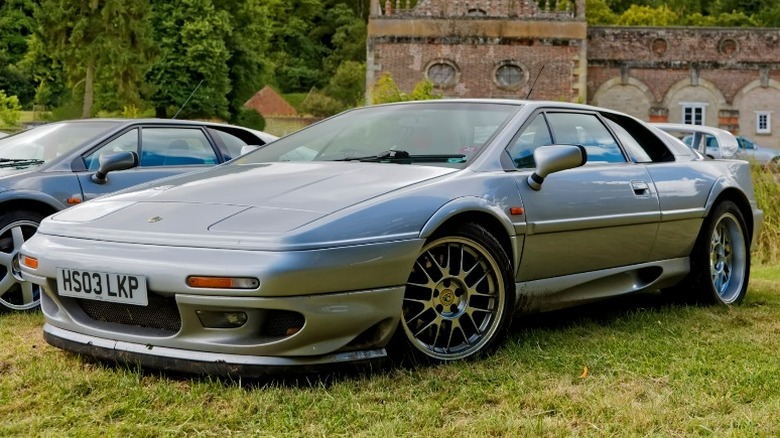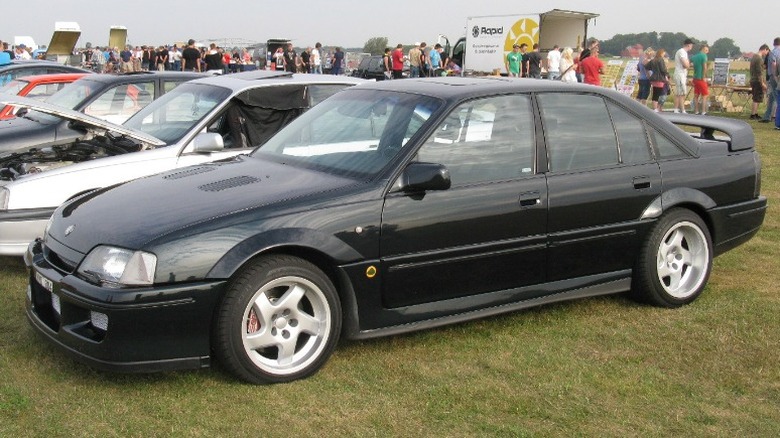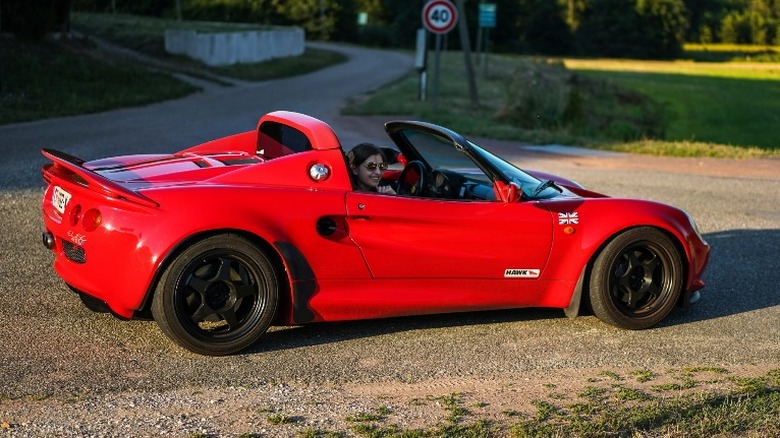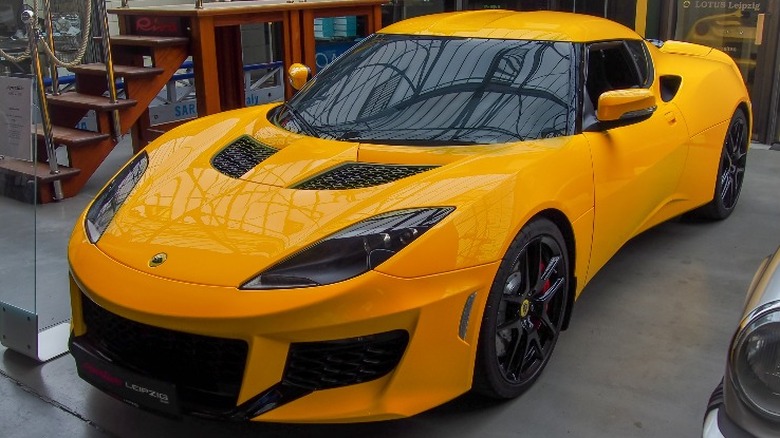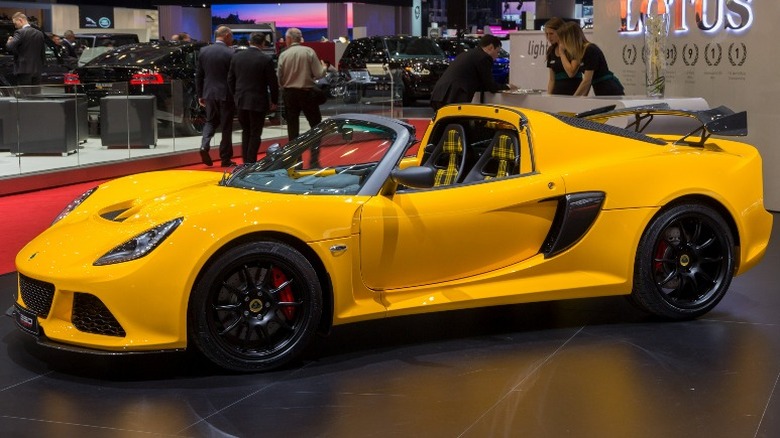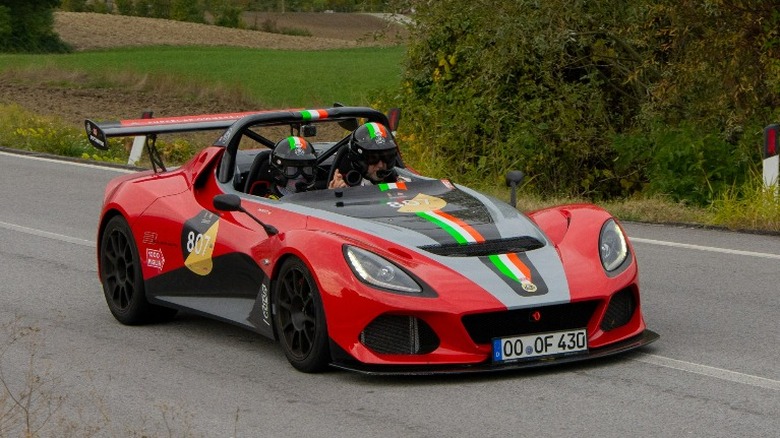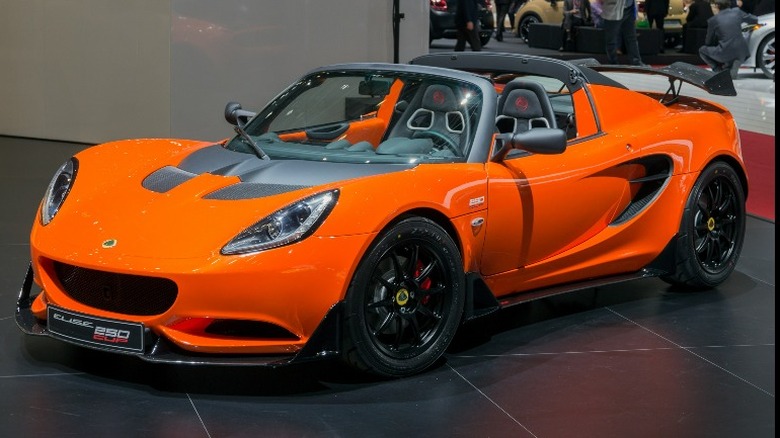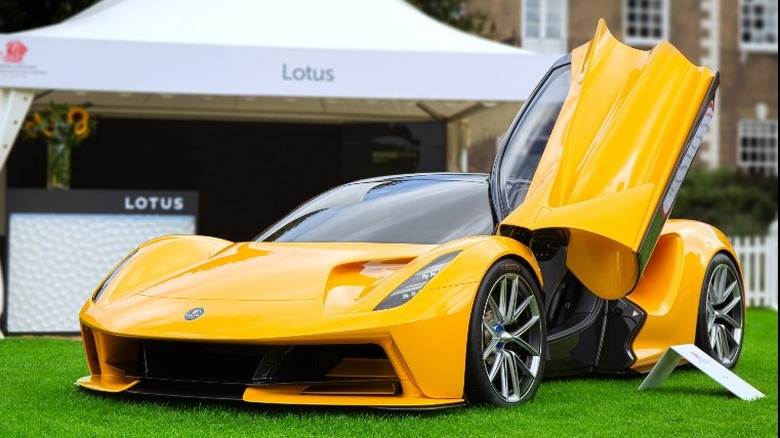The 15 Best Lotus Cars Of All Time
For more than 70 years, Lotus has been producing some of the world's most beautiful and fastest road and racing cars. The company began in 1952, the company notes, when Colin Chapman founded the automaker, selling car kits to buyers interested in building their own racecars. Considered by many as one of the most brilliant automotive engineers in automobile history, Chapman gained notoriety in racing circles for building successful race cars, adding innovative features (within the racing rules and guidelines) that drastically improved the car's performance and outclassed the competition. In the same year, Chapman moved into road car manufacturing by introducing the Lotus 6 (Mark VI), the company's first volume production model (Lotus made 110 cars geared for the hobbyist driver).
Despite experiencing financial difficulties at various times during its history, today, Lotus is one of the leading British sports and racing car manufacturers. Headquartered at the former site of World War II airfield RAF Hethel in Norfolk, England, the car manufacturer is perhaps best known for its highly successful Team Lotus Formula One racing group. However, the company designs and builds high-performance production automobiles that exhibit precise handling and lightweight build characteristics typical of its race cars.
Here are the best Lotus production cars of all time.
Lotus Seven
In 1957, Lotus launched the Seven model to replace the Mark VI, the company's first production automobile. Similar in appearance, the Seven boasted a new steel tubular spaceframe chassis and aluminum bodywork, which later featured a fiberglass nose and fenders. The Lotus Seven is easily recognized by its semi-exposed wheels and individual wheel covers. The shape became popular with dozens of replica kit car companies due to the low cost of production, and the kits are still available for purchase today.
During its sixteen years of production (1957-1973), the Seven employed a variety of engines. The most common engine used in the Series 1 Seven models was the English Ford sidevalve (flathead or L head), producing 49 horsepower. However, Lotus also used the single overhead cam FWA Coventry Climax engine or the BMC series A. Lotus offered the car with a three- or four-speed transmission sending power sent to the rear wheels.
Although the Seven weighed only 896-924lb (406-419kg), the underpowered engine accelerated the sports car to 60 mph in a sluggish 19.2 seconds and reached a top speed of 78-104mph. However, the sports car featured a front independent suspension with lower wishbones, upper links, an anti-roll bar rear live axle with twin trailing arms and diagonal links, coil springs, and telescopic dampers that gave the Seven handling characteristics found only race cars of the period.
Lotus Elite
In 1958, Lotus founder Colin Chapman, looking for funds to support his racing endeavors, began producing a new lightweight sports car, the Elite. The original model employed both fiberglass and fiberglass-reinforced plastic to form a monocoque body shell. The sports car weighed only 1705 pounds and got its power from a single-overhead-cam Coventry Climax 1.2-liter engine producing 102 horsepower.
Lotus applied much of its Grand Prix racing technology to the Elite. The unique construction gave the two-door coupé strength, lightweight, and remarkable aerodynamics with a drag coefficient of just 0.29. Car and Driver's road test in 1960 showed an acceleration of 0-to-60 mph in an impressive, for the time, 8.2 seconds, and a top speed of 123 mph. The car's handling was also exceptional, with four-wheel independent suspension and disc brakes all around. Test drivers wrote: "On the road, one of the most remarkable things about the car is the lightness of the rack-and-pinion steering, and ... the engine never seems to be overworked, and thanks to its aerodynamic shape, the Elite gives far less impression of speed than most sports cars-gliding along at 120 mph while others feel to be laboring at 80 mph."
Although Lotus had great success with the Elite on the racing circuit, both at the professional and club levels (winning its class at Le Mans no fewer than six times), the car was a failure financially. Lotus built nearly 1050 units, and rumor has it that the automaker lost £100 on every car.
Lotus Elan
After the high cost of production and financially disappointing Elite, Lotus designed and manufactured the Elan with cost-cutting as a priority. The company replaced the expensive monocoque body shell with a fiberglass body mounted on steel subframe chassis and managed to keep the weight to a minimum, less than 700kg on the early models. The light weight allowed the moderately powerful Ford-supplied engines to produce excellent performance by contemporary standards. Car and Driver claimed the Elan represented a state-of-the-art performance automobile that mimicked a Formula car for ordinary street use, and "...it fits like a Sprite, goes like a Corvette, and handles like a Formula Junior."
Some enthusiasts argue that the Elan was the first modern sports car (other than perhaps the Jaguar E Type). Contemporaries from Triumph and MG were old technology cars by comparison. The 1964 Elan 1600 boasted a DOHC inline-4, cast iron block 1558 cc engine producing 105 hp at 5500 rpm and 108 lb-ft of torque at 4000 rpm coupled to a four-speed manual transmission. The lightweight, nimble sports car reached 60 mph in a mere 7.1 seconds, the standing quarter-mile in 15.7 seconds at 87 mph, and achieved a top speed of 112 mph.
The best performing Lotus Elan was the Sprint trim, marketed between 1971 and 1973. The roadster generated 126 horsepower giving it a power/weight ratio of 12.21 lb/hp and helping it accelerate to 62 mph in a blistering 6.2 seconds and reach a top speed of 121 mph.
Lotus Cortina
The Cortina looks like a generic economy car with no resemblance to Lotus' other sleek-looking sports cars. However, when Ford Motor Company asked Lotus to collaborate on a project to build 1,000 special Cortina GTs for competition racing in Group 2, the results were remarkable.
The Ford Cortina MK1, produced for 20 years over five generations, became the bestselling car in Britain and arguably the heart and soul of British motoring during the '60s and '70s. However, early sales were disappointing. So, Ford decided to enter the economical and low-maintenance family car in the British Saloon Car Championship, hoping the popular event would help get the Cortina noticed and boost sales. But the Ford Cortina needed more power and performance to compete, so Lotus and Cosworth collaborated with Ford to build the Lotus Cortina using a twin-cam 1558cc engine that produced 105bhp. The road cars reached a top speed of 108mph, but when tuned for racing, the saloon car could achieve over 140mph, a typical supercar speed for the era.
The Ford-Lotus Cortina dominated in competition events. With legendary drivers such as Jim Clark behind the wheel, the race car won the British Saloon Car Championship in 1964 and the 1966 RAC rally two years later. Success on the racetrack translated into explosive road car sales. Ford sold 2,600,000 Cortinas (approximately 7,400 Ford-Lotus versions) over its 20-year lifetime. Ford dealers sold the Lotus-Ford Cortina as the "The Consul Cortina Sports Special."
Lotus Europa
One of the most intriguing sports cars ever made is the original Lotus Europe. Produced between 1966 and 1975, the awkward-styled vehicle was Lotus' first mid-engine production car and the first ever British mid-engine production automobile. The low-slung coupé demonstrated unparalleled handling and road holding capability for a road vehicle that motorcar journalists described as the nearest thing to a Formula car.
Lotus designed the Europa with Colin Chapman's philosophy of "simplify, then add lightness." The automaker installed the lightweight and economical 1.5-liter four-cylinder 82 horsepower Renault engine coupled to a four-speed transaxle, the same powertrain employed by the front-wheel-drive Renault 16 sedan. Lotus rotated the powertrain 180 degrees and placed it behind the passenger compartment in the Europa. Independent tests showed the sports car accelerated to 60 mph in just under 10 seconds with a quarter-mile time of 17.8 seconds at 78 mph.
The unique fiberglass body design is the most controversial feature of the Europa. The unusual high rear deck, tall sail panels, and minimal rear vision inspired the nickname "bread van." Inside the Series 1, the spartan cabin offered fixed side windows and non-adjustable seats.
In 1972, Lotus introduced the Europa Special featuring the "Big Valve" version of the Lotus Twin Cam engine, producing 126 bhp. The last model made, the Special, is the fastest and the most sought-after version of the car, with acceleration from 0 to 60 mph in 6.6 seconds and a top speed of 123 mph.
Lotus Esprit S1
The Lotus Esprit S1, built between 1976 and 1978, is perhaps more famous for the publicity provided by its role in the James Bond film "The Spy Who Loved Me" than its technological contribution to the development of Lotus automobiles. However, the sports car's wedge shape, designed by the famous Italian car designer, Giorgetto Giugiaro, became a popular choice by automakers for several models in the seventies, such as the 1970 Lancia Stratos Zero, 1972 Maserati Boomerang, and the 1972 E25 BMW Turbo.
The entire Lotus Esprit line, including all the succeeding generations (1976 to 2004), featured the typical mid-engined coupe configuration, seating for two, and pop-up headlights. The exotic shape of the Esprit S1 and high-performance features qualified the coupe as a supercar of the era. The fiberglass body mounted on the traditional Lotus steel backbone chassis, the Lotus mid-mounted 907 multi-valve engine, and 4-wheel independent suspension were all features of the first Esprit generations.
The capability to transform into a submarine and most of the other ingenious gadgets demonstrated in the James Bond film were unavailable on the production models.
According to accelerationtimes.com, the 1976 Esprit S1 with a naturally aspirated 2.0-liter four-cylinder engine generating 162 bhp at 6200 rpm and 140 lb-ft of torque at 4900 rpm. The supercar accelerated to 60 mph in 7.8 seconds, reached the quarter-mile in 17.2 seconds at 91 mph, and achieved a top speed of 138 mph.
Lotus Essex Turbo Esprit
Lotus' founder, Colin Chapman, had accumulated an impressive list of racing achievements by the early '80s, winning six Formula One world drivers' championships, seven constructors' titles, and even the Indy 500. The engineer's remarkable success on the track using lightweight, technologically advanced racing cars influenced the design and manufacturing of Lotus road cars resulting in high-performance production sports cars with flawless handling. The highly successful Lotus 7, Elite, and Elan were all developed using the same design ethos.
Lotus built many outstanding Espirit models between 1976 to 2004, and some would argue the S1 is the best of the lot. However, not satisfied with the performance of either the S1 or S2 models, Chapman introduced the Essex Commemorative Edition Esprit in 1980, boosting performance to a level on par with the current Lotus track cars. Lotus installed a 2.2-liter twin-cam four-cylinder featuring a Garrett turbocharger driving twin Dell'Orto carburetors. The engine produced 210 horsepower at 6500 rpm and 200 lb-ft at 4,500 rpm pushing the supercar to 60 mph in a mere 5.6 seconds on its way to a top speed of 140 mph.
Lotus improved handling with a redesigned backbone chassis for the Turbo Esprit, coupling it to a wider front box section and a new rear space-frame engine and transmission section. The change increased rigidity by 50 percent over previous models. An independent upper-wishbone with lower-transverse-link suspension up front and the unequal-length transverse links in the back gave the Esprit racecar handling characteristics.
Lotus Esprit V8
In 1996, Lotus completely redesigned their Esprit line introducing a new V8 model with an appearance more appropriate for modern cars. Rather than out-source a third-party V8 with an established performance and reliability record, Lotus designed and manufactured its own powerplant. The all-aluminum engine featured 90 degrees between its cylinder banks, a flat-plane crankshaft, and a pair of Garrett turbochargers to boost power.
Lotus engineers designed the V8 with a potential of producing up to 500 bhp, but they detuned the powerplant to work with the less-than-robust Renault-sourced transaxle used on other less powerful Esprit models. While a 500 bhp engine would have given the Esprit hypercar status, the lower horsepower version was no slouch. The turbocharged 3.5-liter V8 producing 350 bhp at 6500 rpm and 295 lb-ft at 4250 rpm blows away much of the competition with a 0-60mph dash in 4.4 seconds, a quarter-mile time of 13.3 seconds at 117 mph, and a top speed of 179 mph.
Although the Esprit V8 was a beautiful and compelling sports car with impressive performance characteristics, the model was greeted with lukewarm early reviews. Buyers were generally reluctant to part with £60,000 (just over $100,000) for a Lotus, regardless of performance. Today, a 1996 Esprit V8 sells for an average price of $42,000.
Lotus Carlton
Rumor has it the Lotus Carlton was so fast the British government tried to pass legislation making the car illegal after some criminals used one as their escape vehicle and embarrassed the police chasing it, who could not keep up.
The high-performance Lotus Carlton (or Omega) began its production process when Lotus engineers disassembled an Opel/Vauxhall large sedate family sedan and started replacing or modifying components acquired from other GM suppliers and manufacturers.
Opel/Vauxhall sent a standard 3.0-liter, 24-valve engine to Lotus for upgrades before installation in the new car. The Lotus team increased the capacity of the straight-six to 3.6 liters, added a water-cooled intercooler, and installed two Garrett T25 turbochargers. Lotus also adapted the engine management system and changed the ignition to an AC Delco type (from the Lotus Esprit). The upgraded engine produced a whopping 377 bhp at 5200rpm and 419 lb-ft of torque at 4200rpm.
To convert the original family sedan to a vehicle with handling characteristics worthy of a Lotus, the company installed a Lotus-tuned chassis, reworked the suspension and aerodynamics, upgraded the brakes, and added performance tires. Lotus claimed acceleration of 0-to-60 in 5.2 seconds and a quarter-mile time of 13.6 seconds at 109 mph. The Lotus Carlton reached an unrestricted top speed of 175 mph, the vehicle becoming the fastest four-door saloon on the market, even beating out the competition from the BMW M5 (too fast for the police to catch!).
Lotus Elise S1
When the Lotus Elise S1 debuted in September 1995, critics described it as the world's most advanced sports car. Although Lotus initially envisioned the Elise S1 as a limited production model, the stellar reviews declared it part of the new generation of lightweight, agile, and high-performance cars, and sales boomed. The diminutive sports car racked up numerous trophies, including several "Car of the Year" honors, and even contended for the Prince of Wales Award for Innovation.
Lotus chose the Rover K Series 1.8-liter engine for the Elise S1 primarily for its lightweight. The naturally aspirated mid-mounted four-cylinder coupled to a five-speed manual transmission generated only 118 bhp at 5500 rpm and 122 lb-ft. at 3000 rpm. However, the sports car weighed a mere 1611 pounds (curb weight), about half the weight of an average family saloon. The lightweight compensated for the seemingly anemic power output, producing an impressive acceleration and responsive handling. The Elise S1 accelerated to 60 mph in 5.8 seconds and reached the quarter-mile in 14.49 seconds on its way to a top speed of 126 mph.
While the Lotus Elise S1 body style, with exaggerated curves, swoops, and vents, was unique for its time, the austere interior was anything but state-of-the-art, providing little comfort for the driver and passenger even on a short trip. The cabin provided no air conditioning or carpets, and the thin leather-clad seats looked too fragile to use. But the lack of amenities meant less weight and ultimately better performance.
Lotus Evora GT
The 2020 Lotus Evora GT, made for the North American market, replaced the Evora 400 and 410 models providing more power, improved aerodynamics, and a characteristic typical of every new Lotus, "added lightness." The company offered the GT in a two-seat or a 2+2 seat configuration. The Toyota-sourced mid-mounted, the supercharged 3.5-liter six-cylinder engine produced 416 horsepower and 317 lb-ft of torque (332 lb-ft of torque with the automatic) connected to a six-speed manual or a six-speed automatic transmission. A limited-slip differential added to the manual gearbox version improved rear-wheel traction. The powertrain pushed the exotic sports car to 60 mph in a blistering 3.8 seconds and a top speed of 188 mph.
Lotus augmented the usual outstanding handling by offering four selectable traction modes: Sport, Race, Drive, and Off. Both the Sport and Race modes increase throttle response permitting more traction slip before the system takes control, resulting in enhanced driver enjoyment without the risk of pushing things too far. The hydraulically boosted steering offers an exceptional feel and responsiveness that directs the car wherever the driver indicates.
Perhaps more significant to performance than the improvements in power are the subtle aerodynamic changes that maximize airflow resulting in a maximum downforce of 141 pounds, twice the downforce of the Evora 400. And, of course, Lotus' specialty, "lightness," also contributed. Extensive use of carbon fiber components throughout the car, including rear-wheel arch vents, front fender panels, and the rear bumper contribute to weight reduction.
Lotus Exige Cup 430 Final Edition
The Exige is arguably the best car Lotus has ever made. Introduced in 2000, the entire Exige line consists of high-performance versions of the Elise. Lotus offered the models with a variety of chassis and engine options that included the latest in technology, all with the goal of creating a road car that performed well on the track. The Exige S, launched in 2014, features a supercharged 3.5-liter V6 engine that produces an impressive 345bhp and accelerates to 60mph in only 3.8 seconds.
When the executives at Lotus decided to make 2021 the Exige's final year of production, they sent the high-performance sports car out with a bang. Lotus offered several outstanding variants, but the Exige Cup 430 Final Edition was the cream of the crop. Every design feature of the Exige Cup 430 focused on performance. The suspension featuring adjustable Eibach front and rear anti-roll bars and three-way Nitron adjustable dampers (high- and low-speed compression and rebound) provided unparalleled handling. The 430 horsepower supercharged Toyota V6 also delivered all the power needed to blow away most competitors on the road or track.
Regarded by many as the world's quickest "real-world sports car," the Exige Cup 430 will hit 62 mph in 3.4 seconds and reach a top speed of 174 mph with the help of an aero package balancing downforce at all speeds (76kg front and 95kg rear) for a total of 171kg.
Lotus 3-Eleven
Lotus founder Colin Chapman passed away in 1982, but he left a legacy of racecar engineering and innovation unmatched by other notable pioneers of the automobile industry. His steel backbone chassis and suspensions were unique, and his rear strut designs (the equivalent of MacPherson struts) are still called Chapman struts. In racing, Chapman popularized the monocoque chassis and spearheaded the use of aerodynamics for Formula 1. He was an innovator of "ground effects," but his most notable achievement was perhaps his "adding lightness" car design philosophy.
When Lotus engineers designed the 3-Eleven, they followed Chapman's ethos of simplicity and emphasis on weight reduction. The 3-Eleven produced from 2015 to 2018 weighs a mere 2,028 lbs. It generated power with a revised Toyota-sourced supercharged-and-tuned 3.5-liter V-6 engine rated at 450 horsepower at 7,000 rpm and 332 lb-ft of torque from 3,500 rpm to 6,500 rpm. The power-to-weight ratio is a remarkable 467 horsepower per metric ton.
Lotus offered the 3-Eleven in two configurations: Road and Race. The Race version boasts paddle shifters, an oil cooler, a six-speed sequential transmission with a semi-dry-sump, and a limited-slip differential, while the Road variant features an oil cooler, six-speed manual transmission with a high-performance clutch assembly, and a Torsen limited-slip differential.
Both versions feature an open-cockpit design using resin infusion composite body panels that Lotus claims are 40% lighter than GRP (glass reinforced plastic). However, the Race roll cage uses more side impact protection than the Road version to meet motorsports rules.
Lotus Elise Cup 240 Final Edition
The Elise Cup 240 Final Edition was the last hurrah of the iconic Lotus Elise line that began in 1996 and ran until ran for three generations through 2021. While some might say Lotus saved its best for last, the Cup 240 Final Edition represents an accumulation of innovation and upgrades throughout the 25-year run.
When Lotus first launched the Elise, a meager 118 horsepower engine powered the roadster. However, designed with Chapman's "added lightness," the sports car weighed a paltry 1,598 lbs. and could accelerate to 60 mph in an impressive 5.8 seconds. Lotus offered two final editions to finish the Elise line production: the 240 and 250 models. Both models have evolved over the years with the traditional Lotus emphasis on lightweight. The modern Elise Cup 240 Final Edition weighs only a few hundred pounds more than the original Elise, even with a larger engine and additional safety equipment.
The iconic small and agile two-seater fitted with a mid-mounted, supercharged, and chargecooled 1.8-liter Toyota four-cylinder engine produces 240bhp and 244Nm of torque. While the 250 Final Edition offers more power than the 240, Bilstein dampers, adjustable anti-roll bars, and an aero kit, it pays the price with more weight. For Lotus cars, lighter is always better. The 240's exceptionally lightweight and robust engine deliver a remarkable acceleration from 0 to 60 mph in a mind-boggling 4.5 seconds.
Lotus Evija
With the introduction of the Lotus Evija, the high-performance British sports car company entered the era of hypercar electric vehicles. Lotus built the Evija model as a fully electric vehicle, including an ultrafast charging setup that requires only 12 minutes for an 80% charge and 18 minutes for a full charge.
The Evija exterior design was motivated by race car aerodynamics, including butterfly doors and a large rear wing. Consistent with the Lotus tradition of building lightweight cars, the company sourced the four electric motors featuring slim helical gear ground planetary gearboxes from Integral Powertrain Ltd. The gearbox and motor combination for each drive unit are compact and lightweight, helping reduce the total vehicle weight. Lotus claims the motors produce a total output of 1972 horsepower and 1254 lb-ft of instant torque, which is more power at each wheel than any other Lotus road car and just under double the horsepower generated by more expensive hypercars such as the Aston Martin Valkyrie at 1,160 horsepower. A single-speed automatic transmission sends power to all four wheels.
The all-carbon-fiber Lotus Evija, with its 2,000-kW lithium-ion battery, weighs a mere 3,703 pounds. The suspension, featuring three adaptive spool-valve dampers at each axle, ensures the hypercar remains under control when cornering at excessive speeds. The Evija's estimated acceleration to 62 mph in under three seconds and the hypercar can reach a top speed of more than 200 mph. Lotus plans to build only 130 Evija models priced at just over $2 million.
